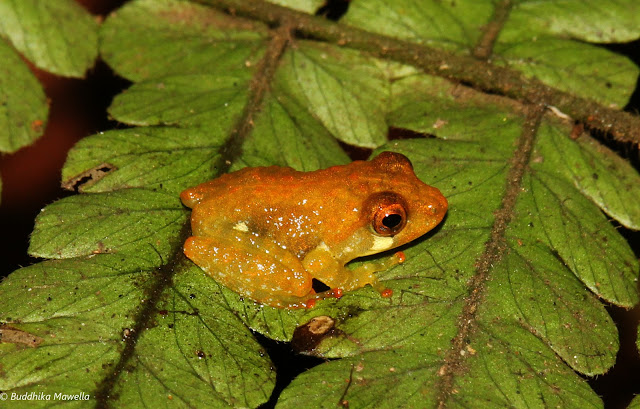English: Half-webbed Pug-snout Frog
Binomial: Uperodon palmatus/Ramanella palmata
Sinhala: පාකර්ගේ මොට හොඹු මැඩියා[Pakerge mota hombu madiya]
Half-webbed Pug-snout Frog is an endemic species of frogs restricted to the central highlands of Sri Lanka. Above photographed specimen was found close to a forest in Nuwaraeliya district and the elevation above sea level of the location was about 1894m. It is considered to be a rare species due to the limited distribution of the population. This frog is morphologically more similar to Uperodon obscurus. But the differences in webbed feet can be used to distinguish one form other.
Currently limited researches have been done related to the breeding biology of this species. According to those researches, Mr. Anaslem de Silva has reported that he has observed the tadpoles of this frog in phytothelms in Horton National Park (de Silva, 1999). In addition to that in a research done by Dr. Kanishka Ukuwela and others have reported that they have observed the tadpoles of this frog in rock pools close to a stream in Seetha Eliya(Ukuwela, Silva, and Athukorala 2010).
IUCN Red List status of this amphibian is 'Endangerd'. Agricultural activities, logging, forest dieback and droughts can be regarded as major threats for the species.
References:
-
De Silva, Anselm. 1999. The habitat preferences and the status of amphibians and reptiles at Horton Plains National Park. Report, Zoological Survey of Sri Lanka. National Science Foundation, Colombo. 67 pp.
- Ukuwela, K. D. B., E. I. L. Silva, and N. P. Athukorala 2010 The Tadpole of Ramanella Palmata (Anura: Microhylidae), a Frog Endemic to Sri Lanka. Zootaxa 2628: 63–65.
- The IUCN Red List of Threatened Species(tm) 2015-4 - http://www.iucnredlist.org
- Manamendra-Arachchi, K. & R. Pethiyagoda (2006): Sri Lankan amphibians [in Sinhala]. – WHT Publications, Colombo



















































